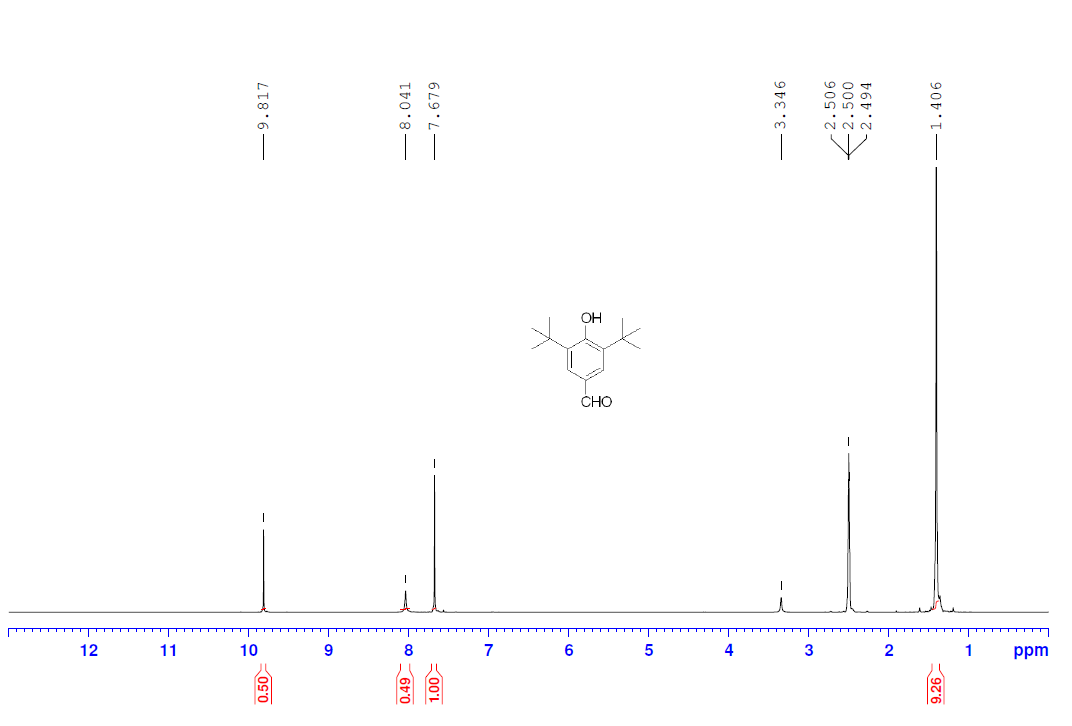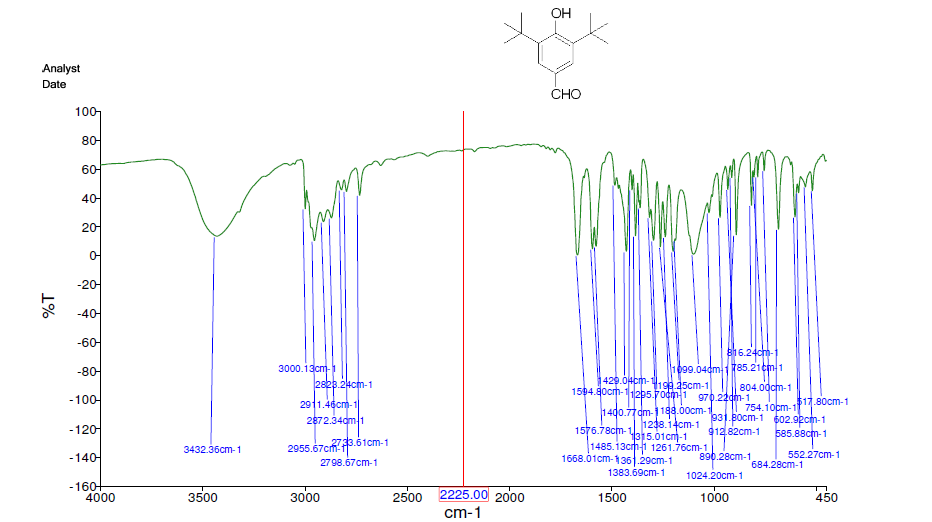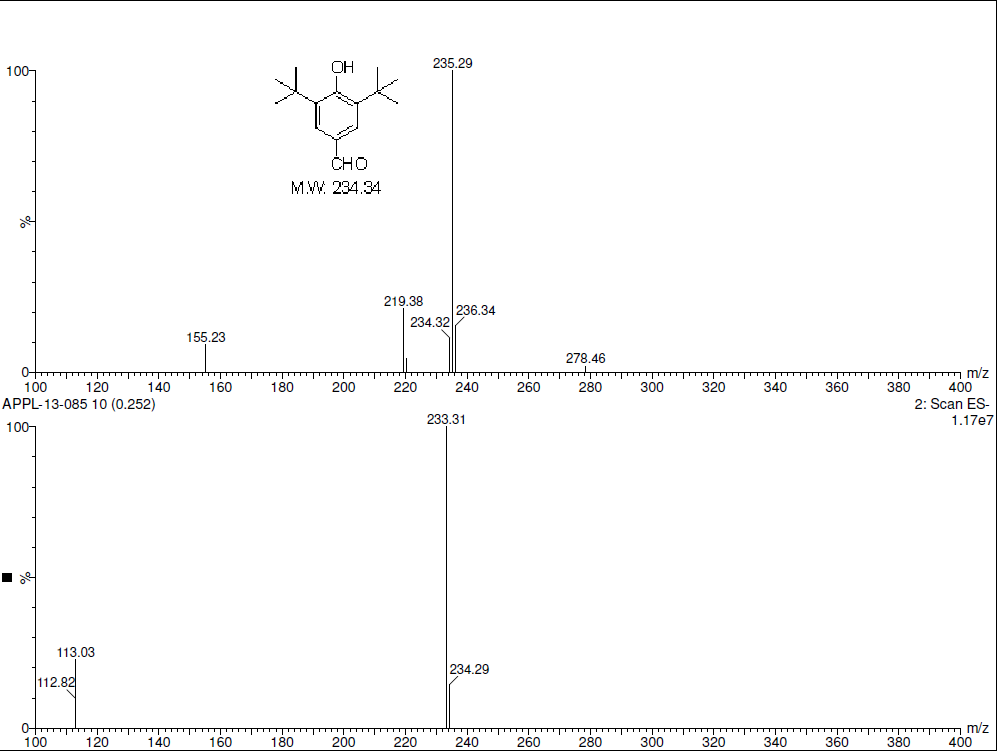3,5-Di-tert-butyl-4-hydroxybenzaldehyde CAS#: 1620-98-0; ChemWhat Code: 60623
Identification
| Patent Information | ||
| Patent ID | Title | Publication Date |
| JP2018/168093 | BIOFILM FORMATION INHIBITOR | 2018 |
| WO2016/63297 | ALKYLIDENE PHOSPHONATE ESTERS AS P-GLYCOPROTEIN INDUCERS | 2016 |
| US2013/267568 | (1,2,3-Triazolyl)sulfonyl Derivatives | 2013 |
| US2011/54018 | Inotilone derivatives as coherent biological response modifier (cBMR) | 2011 |
| US2010/267992 | PROCESS FOR PREPARING SUBSTITUTED 1,4-QUINONE METHIDES | 2010 |
Physical Data
| Appearance | Off-White to pale yelow solid |
| Melting Point, °C | Solvent (Melting Point) |
| 190 | toluene |
| 189 – 191 | |
| 185 – 189 | |
| 188 – 190 | |
| 166 – 171 | |
| 188 – 191 | ethyl acetate |
| Measurement Temperature, °C |
| 25 |
| Description (Association (MCS)) | Partner (Association (MCS)) |
| IR spectrum of the complex | ethenetetracarbonitrile |
| UV/VIS spectrum of the complex | ethenetetracarbonitrile |
Spectra
| Description (NMR Spectroscopy) | Nucleus (NMR Spectroscopy) | Solvents (NMR Spectroscopy) | Frequency (NMR Spectroscopy), MHz |
| Chemical shifts, Spectrum | 1H | chloroform-d1 | 400 |
| Chemical shifts, Spectrum | 13C | chloroform-d1 | 100 |
| Chemical shifts, Spectrum | 1H | dimethylsulfoxide-d6 | 400 |
| Chemical shifts, Spectrum | 13C | dimethylsulfoxide-d6 | 100 |
| Chemical shifts, Spectrum | 1H | CD3OD | 400 |
| 3,5-Di-tert-butyl-4-hydroxybenzaldehyde CAS#: 1620-98-0 NMR |  |
| Description (IR Spectroscopy) | Solvent (IR Spectroscopy) | Original Text (IR Spectroscopy) |
| toluene | 1682 cm-1 (aldehyde CO) | |
| Bands | solid | |
| Bands | nujol | |
| Bands | CCl4 | |
| Bands | CS2 | |
| Intensity of IR bands |
| Description (Mass Spectrometry) | Solvent (UV/VIS Spectroscopy) | Comment (UV/VIS Spectroscopy) | Absorption Maxima (UV/VIS), nm | Ext./Abs. Coefficient, l·mol-1cm-1 |
| Absorption maxima | H2O, H2SO4 | Ratio of solvents: 66percent | 258 | 5740 |
| Absorption maxima | H2O, NaOH | Ratio of solvents: 0.1N | 232, 290 | 8600, 3120 |
| Description (Mass Spectrometry) |
| Absorption maximaliquid chromatography mass spectrometry (LCMS), high resolution mass spectrometry (HRMS), electrospray ionisation (ESI), spectrum |
| gas chromatography mass spectrometry (GCMS), spectrum |
| liquid chromatography mass spectrometry (LCMS), spectrum |
| high resolution mass spectrometry (HRMS), electron impact (EI), spectrum |
3,5-Di-tert-butyl-4-hydroxybenzaldehyde CAS#: 1620-98-0 MASS
Route of Synthesis (ROS)
Route of Synthesis (ROS) of 3,5-Di-tert-butyl-4-hydroxybenzaldehyde CAS 1620-98-0
| Conditions | Yield |
| With sodium tetrahydroborate In ethanol at 20℃; | 95% |
| With sodium tetrahydroborate; sodium hydrogencarbonate In ethanol at 0℃; for 2h; Experimental Procedure 1 Synthesis of 3,5-di-tert-butyl-4-hydroxybenzyl alcohol Take 4 g of the above prepared3,5-di-tert-butyl-4-hydroxybenzaldehyde (0.017 mol) was dissolved in 40 mL of absolute ethanol,1.7 g of NaHCO3 (0.02 mol) was added, and 0.77 g (0.02 mol)NaBH4 continued to react for 2 h, ending the reaction.Ether extraction, the organic phase was combined, washed and dried, and the solvent was removed under reduced pressure to give 3.7 g of a pale yellow solid,Yield 93%, m.p. 140-141 ° C (literature value 139-141 ° C). | 93% |
| With sodium hydroxide; sodium tetrahydroborate In methanol for 27h; Ambient temperature; | 47% |
Safety and Hazards
| Pictogram(s) |  |
| Signal | Warning |
| GHS Hazard Statements | H315 (100%): Causes skin irritation [Warning Skin corrosion/irritation] H319 (100%): Causes serious eye irritation [Warning Serious eye damage/eye irritation] H335 (90.91%): May cause respiratory irritation [Warning Specific target organ toxicity, single exposure; Respiratory tract irritation] |
| Precautionary Statement Codes | P261, P264, P264+P265, P271, P280, P302+P352, P304+P340, P305+P351+P338, P319, P321, P332+P317, P337+P317, P362+P364, P403+P233, P405, and P501 (The corresponding statement to each P-code can be found at the GHS Classification page.) |
Other Data
| Transportation | At room temperature away from light |
| HS Code | |
| Storage | At room temperature away from light |
| Shelf Life | 1 year |
| Market Price |
| Druglikeness | |
| Lipinski rules component | |
| Molecular Weight | 234.338 |
| logP | 4.524 |
| HBA | 1 |
| HBD | 1 |
| Matching Lipinski Rules | 4 |
| Veber rules component | |
| Polar Surface Area (PSA) | 4.524 |
| Rotatable Bond (RotB) | 3 |
| Matching Veber Rules | 2 |
| Toxicity/Safety Pharmacology |
| Quantitative Results |
| Use Pattern |
| 3,5-Di-tert-butyl-4-hydroxybenzaldehyde CAS#: 1620-98-0 widely used in food, polymers and cosmetics as radical trapping agents, OLED materials. |
Buy Reagent | |
| No reagent supplier? | Send quick inquiry to ChemWhat |
| Want to be listed here as a reagent supplier? (Paid service) | Click here to contact ChemWhat |
Approved Manufacturers | |
| Want to be listed as an approved manufacturer (Requires approvement)? | Please download and fill out this form and send back to approved-manufacturers@chemwhat.com |
Other Suppliers | |
| Watson International Limited | Visit Watson Official Website |
Contact Us for Other Help | |
| Contact us for other information or services | Click here to contact ChemWhat |





